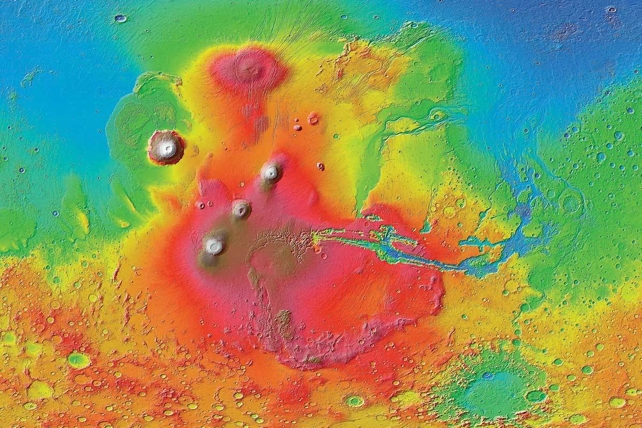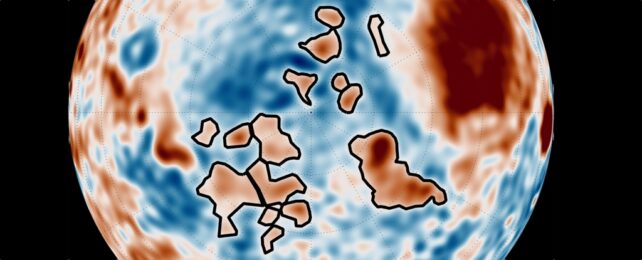A team of scientists presented a new gravity map of Mars at the Europlanet Science Congress 2024. The map shows the presence of dense, large-scale structures under Mars' long-gone ocean and that mantle processes are affecting Olympus Mons, the largest volcano in the Solar System.
The new map and analysis include data from multiple missions, including NASA's InSIGHT (Interior Exploration using Seismic Investigations, Geodesy and Heat Transport) mission. They also use data from tiny deviations in satellites as they orbit Mars.
The paper "The global gravity field of Mars reveals an active interior" will be published in an upcoming edition of JGR: Planets. The lead author is Bart Root of the Delft University of Technology. Some of the results go against an important concept in geology.
Geologists work with a concept called flexural isostasy. It describes how a planet's outer rigid layer responds to large-scale loading and unloading. The layer is called the lithosphere and consists of the crust and the uppermost part of the mantle.

When something heavy loads the lithosphere, it responds by sinking. On Earth, Greenland is a good example of this, where the massive ice sheet puts downward pressure on it. As its ice sheets melt due to global warming, Greenland will rise.
This downward bending often causes an uplift in surrounding areas, though the effect is slight. The more massive the load is, the more pronounced the downward bending, although it also depends on the lithosphere's strength and elasticity. Flexural isostasy is a critical idea for understanding glacial rebound, mountain formation, and sedimentary basin formation.
The authors of the new paper say scientists need to rethink how flexural isostasy works on Mars. This is because of Olympus Mons, the largest volcano in the Solar System, and the entire volcanic region called Tharsis Rise, or Tharsis Montes. Tharsis Montes is a vast volcanic region that holds three other enormous shield volcanoes: Arsia Mons, Pavonis Mons, and Ascraeus Mons.
Flexural isostasy states that this massive region should force the planet's surface downward. But the reverse is true. Tharsis Montes is much more elevated than the rest of Mars' surface. NASA's InSIGHT lander also told scientists a lot about Mars' gravity, and together, it's forcing researchers to reconsider how this all works on Mars.
"This means we need to rethink how we understand the support for the big volcano and its surroundings," the authors write. "The gravity signal of its surface fits well with a model that considers the planet as a thin shell."
The research shows that active processes in the Martian mantle are boosting Tharsis Montes upward. "There seems to be a big mass (something light) deep in Mars' layer, possibly rising from the mantle," the authors write. "It shows that Mars might still have active movements happening inside it, making new volcanic things on the surface."
The researchers found an underground mass around 1750 kilometres across and at a depth of 1100 kilometres. They suspect that it's a mantle plume rising under Tharsis Montes and strong enough to counteract the downward pressure from all the mass.
"This suggests that a plume head is currently flowing upward towards the lithosphere to generate active volcanism in the geological future," the authors write in their paper.
There's debate about how volcanically active Mars is. Although there are no active volcanic features on the planet, research shows that the Tharsis region has resurfaced in the near geological past within the last few tens of millions of years.
If there is a mantle plume under Tharsis Montes, could it eventually reach the surface? That's purely speculative, and more research is needed to confirm these findings.
The researchers also found other gravitational anomalies. They found mysterious, dense structures under Mars' northern polar plains. They're buried under a thick, smooth sediment layer that was likely deposited on an ancient seabed.
The anomalies are approximately 300–400 kg/m3 denser than their surroundings. Earth's Moon has gravitational anomalies that are associated with giant impact basins. Scientists think that the impactors that created the basins were denser than the Moon, and their mass has become part of the Moon.
Impact basins on Mars also show gravity anomalies. However, the anomalies in Mars' northern hemisphere show no traces of them on the surface.
"These dense structures could be volcanic in origin or could be compacted material due to ancient impacts. There are around 20 features of varying sizes that we have identified dotted around the area surrounding the north polar cap—one of which resembles the shape of a dog," said Dr. Root.
"There seems to be no trace of them at the surface. However, through gravity data, we have a tantalizing glimpse into the older history of the northern hemisphere of Mars."
The only way to understand these mysterious structures and Mars' gravity in general is with more data. Root and his colleagues are proponents of a mission that could gather the needed data.
It's called the Martian Quantum Gravity (MaQuls) mission. MaQuls would be based on the same technology used in the GRAIL (Gravity Recovery and Interior Laboratory) and GRACE (Gravity Recovery and Climate Experiment) missions, which mapped the Moon's and Earth's gravity, respectively. MaQuls would feature two satellites trailing each other and connected by an optical link.
"Observations with MaQuIs would enable us to better explore the subsurface of Mars. This would help us to find out more about these mysterious hidden features and study ongoing mantle convection, as well as understand dynamic surface processes like atmospheric seasonal changes and the detection of ground water reservoirs," said Dr. Lisa Wörner of DLR, who presented on the MaQuIs mission at EPSC2024 this week.
This article was originally published by Universe Today. Read the original article.
